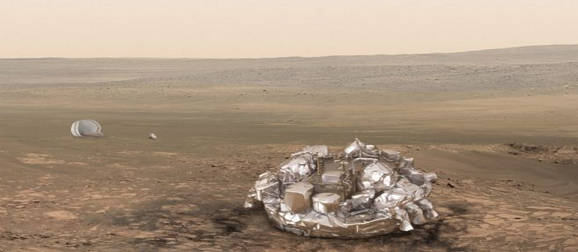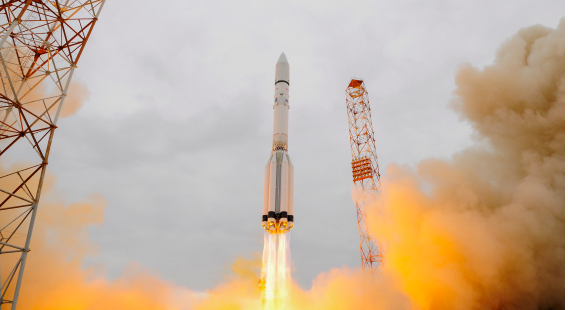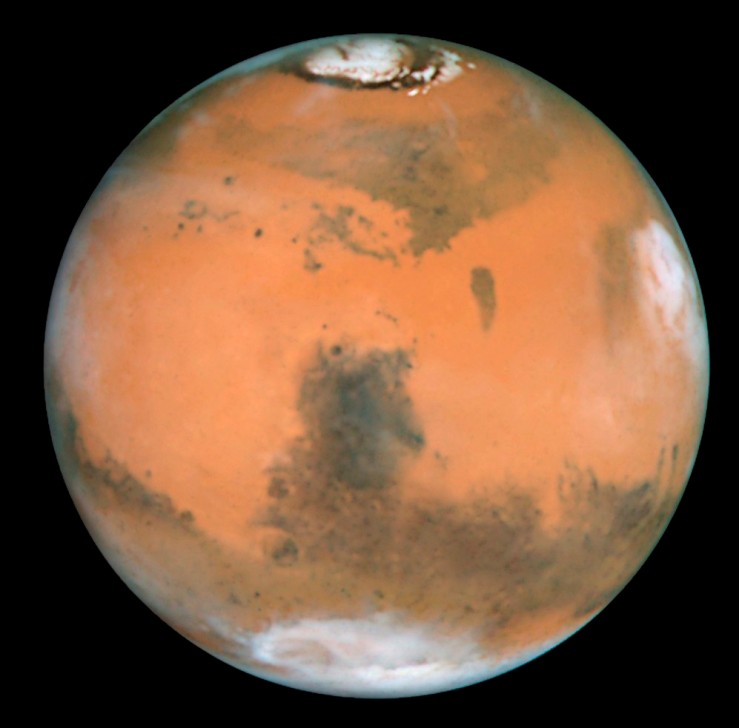On 14 March 2016 the European Space Agency used facilities at Baikonur in Kazakhstan to launch their long awaited mission to Mars, the not so snappily named ExoMars Trace Gas Orbiter (TGO) and, bolted onto it, a smaller probe called Schiaparelli. Although the much larger TGO will only orbit Mars, next Wednesday, 19 October, Schiaparelli will attempt to land on the surface of of the planet, after its seven month journey.
What Schiaparelli might look like on Mars’s surface – Image from ESA
Assuming all goes well, the spacecraft will land on a flat area called Meridiani Planum, close to the equator. Currently this region on Mars is in its dust storm season. Dust storms occur often on Mars and can be very large, covering an area the size of the US, and may last for many weeks. During a dust storm the dust is so thick that it is not possible to see the Martian surface from Earth or even a spacecraft orbiting the planet. It also blocks much of the sunlight from reaching the planet’s surface. This was an important part of the storyline in “The Martian” where the hero’s car batteries were unable to move due to the lack of solar power, nearly stranding him.
Schiaparelli carries a collection of instruments called DREAMS (Dust characterisation, Risk assessment, and Environment Analyser on the Martian Surface), to study the Martian environment.
The DREAMS instruments will be able to measure the local wind speed and direction, humidity, pressure, atmospheric temperature, the transparency (or how the amount of light which which gets through the atmosphere varies) and atmospheric electric fields which may be caused by dust. Unlike nearly all other spacecraft, Schiaparelli will have a non- rechargeable battery. The battery will only last for about a week, after which the spacecraft will run out of power and stop functioning. The decision to go for non chargeable battery was made because Schiaparelli is a relatively simple lander, with a small set of instruments and will have completed its mission within the week in which it will be operational. The main part of the mission, however, is a spacecraft which will orbit Mars for at least 6 years, and this is the TGO.
The aim of the TGO is to study how the distribution of the gas methane varies according to its position on the planet’s surface and over the course of time.
Image from ESA
What is the significance of methane on Mars?
Compared to the Earth, Mars has a very thin atmosphere. Its surface pressure is only 0.6% of that of the Earth. The atmosphere mainly consists of carbon dioxide. However, it also contains a small amount of methane (around 0.000001%) (ESA 2004). This is a puzzle to scientists because the ultraviolet light from the Sun should break up any methane within 600 years, and Mars is 4.5 billions old. Therefore there must be some process occurring on Mars which is constantly replenishing the methane.
Mars- Image from NASA
There are various possibilities for the origin of this methane. One is that it is released by geological processes such as volcanoes or a chemical process occurring within rocks called serpentinisation. This is not as exciting as it sounds (no snakes, I’m afraid) – it is simply a slow chemical reaction between olivine (a mineral found on Mars) carbon dioxide and water which can produce methane. Another is that there is a large reservoir of methane locked away in the ice below the Martian surface and as the temperature varies some of the ice may melt, thus releasing the methane into the atmosphere.
A fascinating possibility is that the methane is created by microorganisms below the planet’s surface. On Earth more than 90% of methane in the atmosphere is produced by living organisms (ESA 2014). There are over 50 species of microorganisms known as methanogens that live off organic matter and produce methane as a waste product. These microorganisms are found not only in wetlands (producing what is known as marsh gas) and in the soil but also in the guts of many animals such as cows and humans. At the risk of sounding somewhat vulgar, the methane gas escapes from both cattle and ourselves in the form of flatulence.
Methanogens
What will the TGO measure?
The TGO will measure how the methane content of Mars’s atmosphere varies with space and time. It will also be able to measure the concentration of other gases such as sulphur dioxide (which on Earth is normally associated with volcanic activity) and organic compounds such as ethane, methanol and formaldehyde (which on Earth are produced by living organisms). Although the TGO won’t be able to say for definite what the sources of the methane found on Mars are, if the concentration of methane were found to vary with the seasons and also if methane were found in conjunction with other organic chemicals it would point towards a biological origin.
How long with the mission be?
The TGO is a joint mission between the European Space Agency (ESA) and the Russian Space Agency (Roscosmos). The mission is described in more detail on ESA (2016). Now it has arrived at Mars it will spend a year gradually adjusting its orbit and by December 2017 it will be in a low circular orbit only 400 km above the Martian surface where it will spend the next 5 years mapping the methane distribution.
References
ESA (2004) Mars Express Confirms Methane in the Martian Atmosphere, Available at:http://www.esa.int/Our_Activities/Space_Science/Mars_Express/Mars_Express_confirms_methane_in_the_Martian_atmosphere(Accessed: 20 March 2016).
ESA (2014) The enigma of methane on Mars, Available at:http://exploration.esa.int/mars/46038-methane-on-mars/ (Accessed: 20 March 2016).
ESA (2016) Robotic exploration of Mars, Available at:http://exploration.esa.int/mars/46124-mission-overview/ (Accessed: 20 March 2016)





[…] to begin searching for the surest sign of life — the gas it leaves behind (Matthew Rozsa, Salon) Schiaparelli on Mars (The Science Geek) Exploration of Mars (ESA Official […]
LikeLike
Very interesting blog
LikeLike
I’m so excited about the possibility of life on Mars. It’s kind of funny the probe was named after Schiaparelli, who indirectly started the “Martian canals” phenomenon. It was obviously wrong, but it contributed so much to science fiction.
LikeLiked by 1 person
Yes if the TGO were to discover evidence that the methane which exists in Mars’s atmosphere is very likely to be biological in origin then the implications would be massive.
LikeLiked by 1 person
Incredibly massive. How do you think this would affect future Mars missions? Do you think we’d have to stop sending probes to Mars, so as not to risk contaminating the life on the planet? Or would we just have to change the process to avoid contamination?
LikeLiked by 1 person
In reply to your later comment. At the moment,
all spacecraft which land on Mars should be treated to prevent the accident contamination of Mars by Earth microbes. The attached link gives a little more more information:
http://mars.nasa.gov/mer/technology/is_planetary_protection.html.
I am not what will happen when we send spacecraft to land on Mars, presumably these standards will be relaxed
The Science Geek
LikeLiked by 1 person
Wonderful. Fingers crossed!
LikeLiked by 1 person
Fascinating stuff–thanks for the layman-decipherable explanation. BTW, if the battery dies in a week, how does the data get sent back to Earth?
LikeLiked by 1 person
The spacecraft will communicate with the TGO which will snd the data back to Earth
LikeLiked by 1 person
Thanks
LikeLike
All digits crossed. 🙂
LikeLike
Though not a scientist by education, by inclination I am captivated by the mysteries and possibilities that continually unfold. Thanks so much for expanding my world. It is fascinating to read in language I can grasp about the continuous endeavors to discover. Methane. Who knew the excitement behind finding the source. I am waiting to hear the results – someday.
LikeLiked by 1 person
Thanks. It will fascinating when we discover what the source of all the methane is.
LikeLike
Reblogged this on Dr. Mohsen Behnam.
LikeLiked by 1 person
I hope it succeeds.
LikeLiked by 1 person
Yes fingers crossed for a successful landing on Wednesday
LikeLike